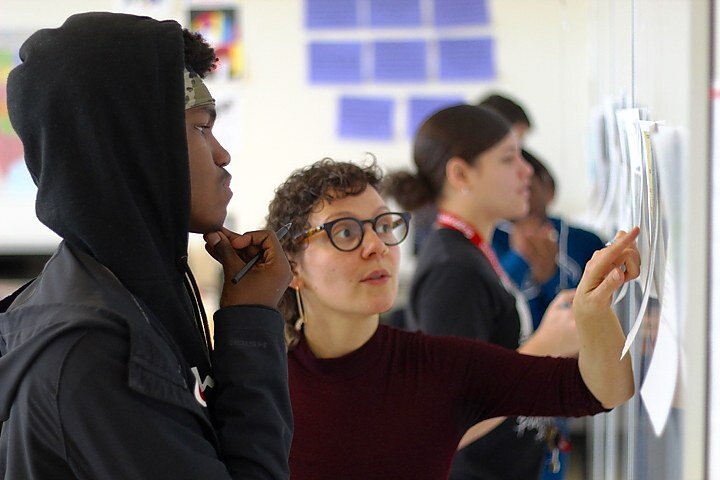The Mandate Behind a Fund for Teachers Fellowship

Nataliya Braginsky is a high school teacher at Metropolitan Business Academy in New Haven, CT, where she teaches African American and Latinx History, Contemporary Law, and Journalism, and co-advises the school’s Gender & Sexuality Alliance (GSA) and Youth Justice Panel. Nataliya is also a 2020 Fund for Teachers Fellow, member of New Haven Educators’ Collective, the Anti-Racist Teaching and Learning Collective, as well as a facilitator of culturally relevant pedagogy and restorative justice workshops. She believes that, as a white teacher working within an education system that has its origins in white supremacy and that continues to perpetuate racism, educators—especially white educators—must take an actively anti-racist stance and make a lifelong commitment to their development toward this goal.
To that end, Nataliya designed a Fund for Teachers fellowship to analyze Los Angeles archives, museums, and historic sites associated with the intersection of African American, Latinx, and Indigenous (AALI) histories to support a new state mandate to teach this subject in all high schools. The mandate was sparked by a growing movement led by youth of color who in 2019 successfully petitioned their legislators. While this legislation does not go into effect until 2022-2023, at Nataliya’s school they decided that this course was long overdue. Such a class is necessary in all schools, but is particularly significant in a school that is majority African American and Latinx.
Learn more about Nataliya’s work in curriculum development, culturally relevant pedagogy and restorative justice practices on her website.
 photo courtesy of the New Haven Independent
photo courtesy of the New Haven Independent
In developing this course, Nataliya surveyed her students. A common request was for untold stories and histories, rather than what is typically taught in history courses. Understanding dominant-narratives while centering counter-narratives is central to the course Nataliya has developed. Another request from students was not to focus only on oppression. As one student expressed: “We barely know the good things, we need to shed light on how brave, strong, and powerful we really are. It’s important to understand our blessings, to have people to look up to who look like us.” While stories of resistance are an important part of the course, students also want to learn of African American and Latinx beauty, joy, and brilliance.
Nataliya is part of the fall 2020 Pulitzer Center Teacher Fellowship program on Arts, Journalism, and Justice. Read the unit she developed, “Writing Personal Narrative in a Political World” posted by the Pulitzer Center, including the publication of two students’ powerful personal narratives.
“In my search for an educational experience that could offer such narratives and resources, Los Angeles was consistently echoed as the epicenter of intersectional AALI history,” said Nataliya. “LA is particularly rich in lesser-known examples of these histories, and many that are not only rooted in resistance, but also in powerful creation. I found numerous historic sites, museums, and archives that showcase the very history my students are asking to learn. That a group of Black, Indigenous, and Latinx people settled Los Angeles, for example, will be incredibly compelling to students.”
Los Angeles fulfills another of Nataliya’s needs as an educator, which is to collaborate. Connecticut is just beginning its collective work in teaching these critical histories, while LA has long led the struggle for intersectional ethnic studies in high schools. Learning from their experiences, sharing lessons and resources, and discussing the complexities of this content will support Nataliya as she continues to develop and improve her course.
Read Nataliya’s most recent article in the Washington Post: “The racist effects of school reopening during the pandemic — by a teacher” and “Not an ‘Achievement Gap’, A Racial Capitalist Chasm” for the Law & Political Equity Project.
Nataliya compiled destinations for her fellowship through talking with Los Angeles historians and educators, and through reading A People’s Guide to Los Angeles. After selecting relevant sites, Nataliya plotted them on this Google map in order to design a thoughtful itinerary.
Information and insights gained from these locations and those whom she meets will inform:
- Students’ creation of a pop-up Latinx museum at her school to accompany a pop-up Black history museum;
- Students’ presentation of final research papers at the school’s annual Social Justice Symposium; and,
- A more balanced and engaging curriculum with a more robust unit on the borderlands.
“Across AALI histories, students will have more stories to draw upon, not only of resistance to oppression, but also stories of creativity, joy, and success,” Nataliya said. “They will have more role models from whom to draw inspiration.”
[minti_divider style=”1″ icon=”” margin=”20px 0px 20px 0px”]
Nataliya earned a B.A. in Liberal Arts from Sarah Lawrence College, and an M.S.Ed. from the University of Pennsylvania. She is most proud of the incredible work accomplished by her students, including:
- A Walking Tour of New Haven’s African American , Indigenous and Latinx History
- Black Is King Compendium
- “The Great Force of History:” The January 6th Syllabus
With any free time, Nataliya leads workshops designed to support educators working toward anti-oppression and liberatory education and writes freelance articles such as this piece about her family’s survival of the Chernobyl nuclear disaster and the lessons it offers for surviving the pandemic.
(Title illustration by Israel Vargas for the Mother Jones article “Digging Into the Messy History of ‘Latinx’ Helped Me Embrace My Complex Identity.”)
 Back to Blogs
Back to Blogs